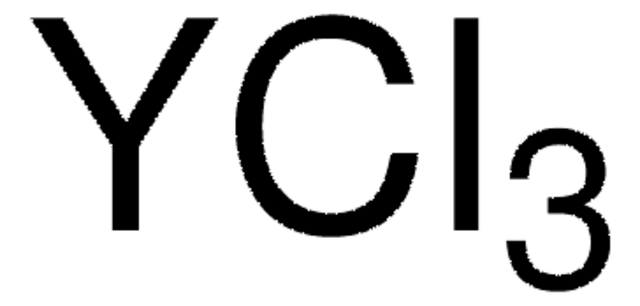211648
Yttrium(III) chloride hexahydrate
99.9% trace metals basis
Sinónimos:
Yttrium trichloride hexahydrate
About This Item
Productos recomendados
Quality Level
assay
99.9% trace metals basis
form
crystals and lumps
impurities
≤1500.0 ppm Trace Rare Earth Analysis
mp
100 °C (dec.) (lit.)
density
2.18 g/mL at 25 °C (lit.)
SMILES string
[H]O[H].[H]O[H].[H]O[H].[H]O[H].[H]O[H].[H]O[H].Cl[Y](Cl)Cl
InChI
1S/3ClH.6H2O.Y/h3*1H;6*1H2;/q;;;;;;;;;+3/p-3
InChI key
IINACGXCEZNYTF-UHFFFAOYSA-K
¿Está buscando productos similares? Visita Guía de comparación de productos
Categorías relacionadas
Application
- Yttrium(III) chloride hexahydrate: This compound is extensively used in the synthesis of yttrium-based materials, including phosphors and ceramics. It acts as a precursor for yttrium iron garnets, crucial components in electronic and optical devices due to their magnetic properties. Additionally, its use in catalysis and materials science research is notable, especially where high purity yttrium is required (Sigma-Aldrich, CAS 10025-94-2).
signalword
Danger
hcodes
Hazard Classifications
Aquatic Acute 1 - Aquatic Chronic 1 - Eye Dam. 1 - Skin Sens. 1B
Storage Class
11 - Combustible Solids
wgk_germany
WGK 3
flash_point_f
Not applicable
flash_point_c
Not applicable
ppe
dust mask type N95 (US), Eyeshields, Gloves
Certificados de análisis (COA)
Busque Certificados de análisis (COA) introduciendo el número de lote del producto. Los números de lote se encuentran en la etiqueta del producto después de las palabras «Lot» o «Batch»
¿Ya tiene este producto?
Encuentre la documentación para los productos que ha comprado recientemente en la Biblioteca de documentos.
Los clientes también vieron
Nuestro equipo de científicos tiene experiencia en todas las áreas de investigación: Ciencias de la vida, Ciencia de los materiales, Síntesis química, Cromatografía, Analítica y muchas otras.
Póngase en contacto con el Servicio técnico












